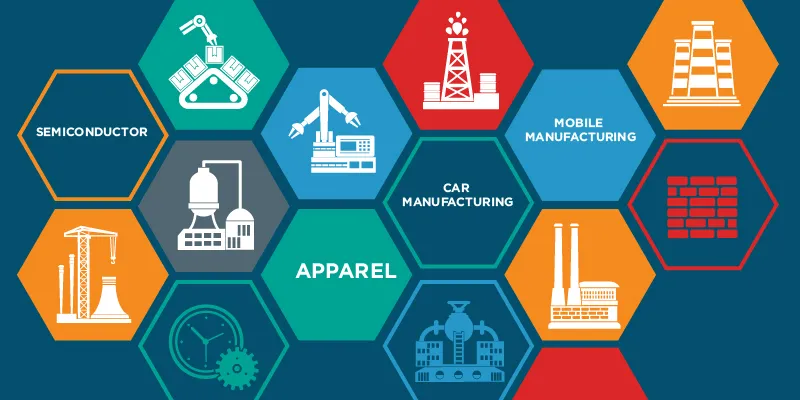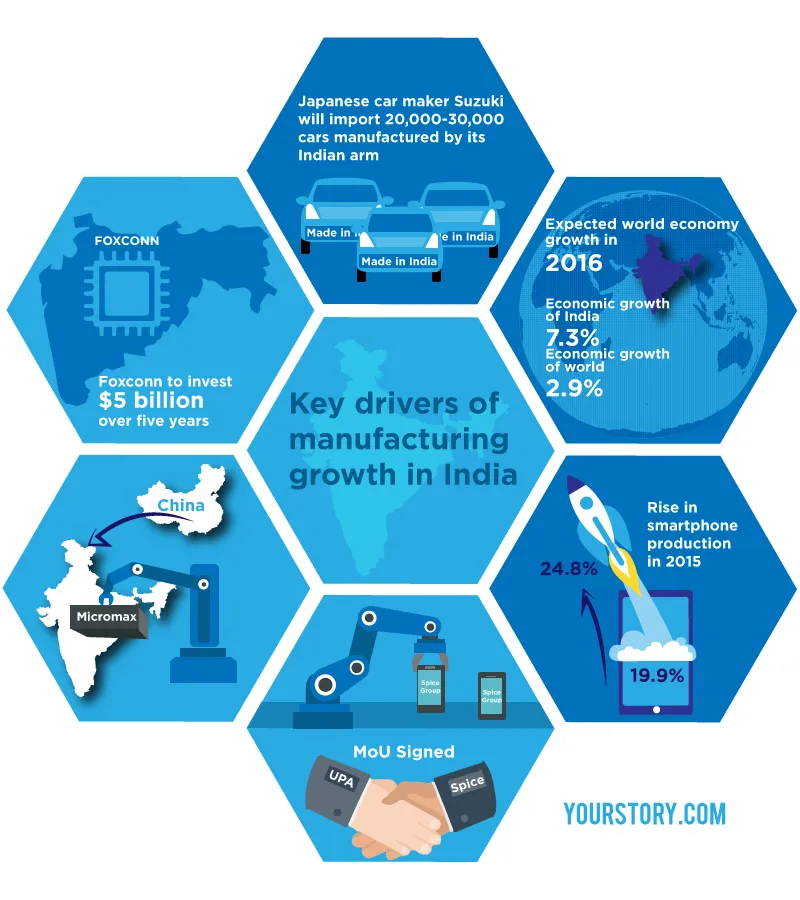Make in India: Will manufacturers ride the red carpet in 2016?
2015 will undoubtedly be known as the year that the Union Government pulled out all stops to drive manufacturing growth in the country through Make in India. The big-bang campaign was promoted through world-class visuals and aggressively marketed by none other than our globe-trotting Prime Minister, who has become the country’s biggest brand ambassador.
On 12 December, MakeInIndia tweeted,
The confidence, especially against the backdrop of a sluggish global economy, is backed by figures that appear to signal an inflection point for Indian manufacturing. In the past 14 months, the government has received proposals ofRs1.20 lakh crore from companies who have expressed an interest in manufacturing electronics in India. Already, smartphones made in India rose to 24.8 percent of total handset sales in April-June 2015, from 19.9 percent in the prior quarter.

In January this year, Spice Group signed an MoU with the UP government to setup a mobile phone manufacturing unit in the state. Smartphone heavyweight Samsung followed up in February, announcing that the Samsung Z1 would be made at its Noida plant. Huawei opened a new research and development (R&D) campus in Bengaluru later in the year. Other handset makers such as Xiaomi, Wistron Corp., and Vivo mobile, among others, have set up or announced the setting up of manufacturing facilities in India. Networking major Cisco recently has unveiled three new products that have been conceptualized and made in India.
Homegrown phone manufacturing major Micromax announced it had begun shifting production from China to India. The company is setting up manufacturing facilities in Uttarakhand, Andhra Pradesh, Rajasthan, Madhya Pradesh and Telanganain a bid ramp up domestic production and reduce its dependence on imports from China.
Micromax Co-founder Rajesh Agarwal told YourStory,
Micromax has been one of the front-runners of the Make in India initiative, by assembling the products locally and quickly ramping up and building complete manufacturing capacity in close partnership with the Government.We are focusing on making India a manufacturing hub and plan to export products from India to other markets. As of today, we are localizing to the extent of 7-8% of our total devices and targetreaching 10% by March 2016.”
A Yen to Make in India
While telecom and electronics are the front-runners, the government has also allowed up to 49% foreign direct investment (FDI) in the lucrative defence sector and 100% in railways infrastructure. Alstom and GE have signed agreements with Indian Railways to set up locomotive manufacturing facilities in the country. The government also announced its plan to invest $10 billion in two semiconductor plants to boost electronic manufacturing sector.Foxconn has committed to investing $5 billion over five years in a high-tech semiconductor manufacturing facility in Maharashtra.
In a move that could change India’s mass transportation landscape, Modi wrapped up a deal with his Japanese counterpart, Shinzo Abe, to bring in the Shikansen high-speed “Bullet” trains to India with transfer of technology and a Make in India component.
Addressing the India-Japan Business Leaders Forum in New Delhi earlier this month, the Prime Minister said, "Today, there is a Make in India movement in Japan. I have been told that $11-12 billion in funds have been earmarked for it. This clearly indicates how both countries can move forward." Modi added that Japan had committed an investment of $35 billion. Abe too has stated that Japanese companies would get ¥1.5 trillion to support their participation in the Make in India initiative.
And in what can only be described as coming full circle, Japanese car maker Suzuki will import 20,000-30,000 cars manufactured byits Indian arm, Maruti Suzuki, under the Make in India initiative. Amitabh Kant, Secretary,Department of Industrial Policy & Promotion, GOI, tweeted recently,
Maruti will be exporting Baleno cars made in India to Japan. We have come a long way! Now need 2 accelerate!” and followed it up with, “Japanese companies rank India as No 1 most promising investment destination in the medium term.”
Schemes for startups
The Prime Minister has also announced the government’s Startup India Initiative, which will encourage entrepreneurship among Indian youth at the grassroots level. The action plan for this will be unveiled on 16 January. The scheme is widely expected to get tax breaks at the next Union Budget. When Modi made the announcement on Independence Day 2015, he said that each of the 1.25 lakh bank branches in the country should encourage at least one Dalit or Adivasi entrepreneur, and at least one woman entrepreneur.

Since then, several government bodies and associations launched a number of schemes and initiatives to promote the needs of startups and entrepreneurs. In September, the National Research Development Corporation (NRDC) urged the centre to grant Rs250 crore in seed funding to 500 manufacturing startups.
Dr H Purushotham, Chairman and MD, NRDC said the proposal is being examined by the Ministry of Science and Technology, following which the NRDC would constitute an investment committee and decide the parameters on which investments will be made.
NRDC provides value-added services to manufacturing startups under the Programme for Inspiring Inventors & Innovators (PIII) and the Programme for Development of Technologies for Commercialization (PDTC).
NRDC’s new-year resolution is to empower at least one manufacturing startup a day so that our contribution adds to the government’s Make in India and Startup India initiatives of Government of India,” Purushotham told YourStory.
Startups in India can also avail loans under the Pradhan Mantri MUDRA Yojana (PMMY).
What startups have to say
“Make in India is a long-term campaign and has a very bright future if all the stakeholders continue to take steps in the right direction. India has all the right skills to increase the share of manufacturing in its GDP,” said SamayKohli, Co-founder, Grey Orange, a robotics startup. Grey Orange has one manufacturing unit and one assembly unit in Gurgaon, where it designs and builds products to help e-commerce, logistics and manufacturing companies improve productivity and automate processes in their warehouse operations.
GreyOrange plans to move to a new office space of about 1.5lakh sqft, with manufacturing and assembly unit spread over 2.5 lakh sqft.
According to Ather Energy Co-founder Tarun Mehta,
The government is quite keen to promote startups. They have launched a range of schemes to promote electric vehicles, which is very startup-friendly. To be honest, I think structurally, the government, in the initial stages, can be more helpful to SMEs rather than startups, which should ideally be designed for scale and a lot of potentially risky experiments.”
The Bengaluru-based automotive startup aims to developAther-S340, a connected vehicle powered by a lithium-Ion battery pack featuring a digital touchscreen dashboard and a light-weight aluminium chassis; the vehicleoffers a top speed of 75 kmph. After two years of design and engineering efforts, Atherwill invest Rs. 25 crore in early 2016 to kick-start the manufacturing of the S340.
Mohammed Hussain Naseem, Co-founder and CEO of GetActive, had a different take. “This space is yet to witness real action. IoT seminars, government forums, smart cities, etc. are creating enough buzz. However, on the policy front, we would like to see cash on the table and single-window clearance for SMEs.”
GetActive is a wearable healthtech startup with one product, the GetActive Slim activity tracker, already in the market and the GetActiveTapp wristband due out soon. In 2015, GetActive manufactured 50,000 units with an investment of Rs. 2.5 crore, and sold these in India, South Asia and Ireland. In 2016, the company plans introduce new products with specialised sensors for heart rate and other vital parameters. It also plans to expand to South Asian, the Middle East, Australia and New Zealand.
What Make in India can really do for the economy
The Make in India initiative has showcased India as a potential manufacturing hub in the eyes of the whole world. According to India Brand Equity Foundation, India’s manufacturing sector could touch $1 trillion by 2025. The sector has the potential to contribute 25-30 percent of the country’s GDP and create up to 90 million domestic jobs in the next 10 years. What’s needed now is to ensure that those who have stepped up to the challenge are not left frustrated by policy paralysis, bureaucratic bottlenecks and impediments to execution that can be the undoing of the best laid plans.







